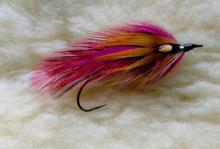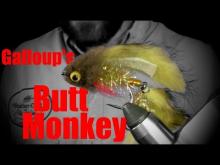Book review: Clouser's Flies
It sure is nice to see Bob's flies celebrated in such a book. Heavy bond paper with a glossy sheen, beautiful full color photos, and lots of step-by-step instructions. Very nice.
Bob Clouser needs no introduction here. It is the rare angler who has not fished a Clouser Minnow, and rarer still one who has never heard of one. Whether in freshwater or saltwater, it is almost universally effective on all manner of gamefish. I myself have caught more largemouth bass on a chartreuse and white clouser minnow than all other flies combined. Just about every angler has their favorite version, and many have brought notoriety to themselves by adding a twist or two to the basic design and assigning a new name. Clearly, few anglers and fly designers have had a more universal impact than Bob Clouser.
"Clouser's Flies" is not just about that famous fly, however. As with most fly tying books, the first section deals with Bob's thoughts on fly tying materials. This is not a general course in tying materials, however, which is good. He limits the discussion to those materials that are used in the flies demonstrated in the book, and in particular his likes and dislikes. For example, in the section that talks about painting lead eyes, he's not shy about saying he uses lacquer, but goes on to state that you can use other methods. I don't know about you, but I figure Bob Clouser has painted more than his share of lead eyes and probably knows from experience which combination of paints and coatings is most durable. I just think whatever method I might try that is different from his, he has probably already tried and discarded. I'm not saying he knows all, but I think I am saying he knows more than me. At least about the materials used to tie his flies.
He also spends a bit of time with tying techniques centered around thread handling. Some of this is basic stuff, but certainly it is helpful to know the exact technique he uses to attach lead eyes to a round hook shank. I can't count how many times I've seen a post on a fly tying bulletin board asking about the techniques for tying in lead eyes. As with the painting - it's worthwhile to pay close attention to Bob's techniques. If there was a better way, he'd probably have heard about it by now.
The bulk of the book deals with the different fly patterns that Bob has developed over the years, including of course the classic Clouser Deep Minnow, as well as some variations on that design such as the Fir Strip Clouser, Rattle Clouser, Super Hair Deep Minnow, Half and Half (the other half being Lefty's Deceiver), and so on. In fact, one entire section of the book is devoted to this style of fly - upside down batifish imitations tied around lead eyes. The other sections of the book deal with other subsurface flies, such as Clouser's swimming nymph, and surface flies, especially his well known Crippled Minnow. Each fly chapter contains a bit of introductory text and several step-by-step full color photographs of the tying procedures. None of the flies are especially difficult to tie, but where there are less obvious steps in their construction, the photographs are a clear help.
I'm sure Bob hears quite often from his collegues that "it is about time" that he wrote this book. I'd like to echo that sentiment. The Clouser Deep Minnow has been around for so long, and there have been so many successful variations created, that this book is long overdue. I can only guess that, like any fisherman, Bob probably was more interested in catching fish or tying flies than writing books. I can't blame him, but I'm sure glad he finally took the time to tell the stories. It's good reading.
Read more about why you should register.
More content from the front page
Since you got this far …
… I have a small favor to ask.
Long story short
Support the Global FlyFisher through several different channels, including PayPal.
Long story longer
The Global FlyFisher has been online since the mid-90's and has been free to access for everybody since day one – and will stay free for as long as I run it.
But that doesn't mean that it's free to run.
It costs money to drive a large site like this.
See more details about what you can do to help in this blog post.



























































